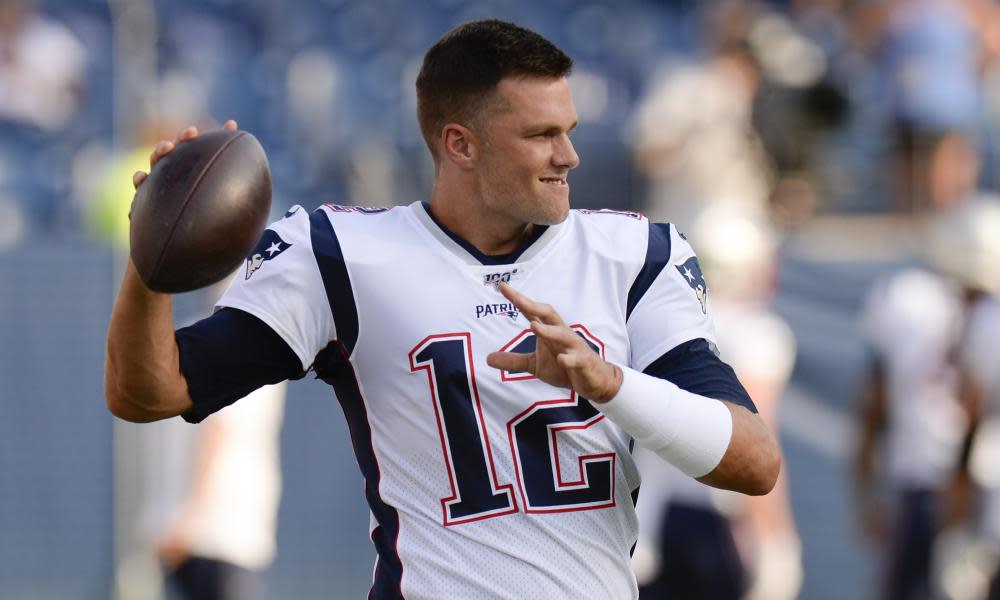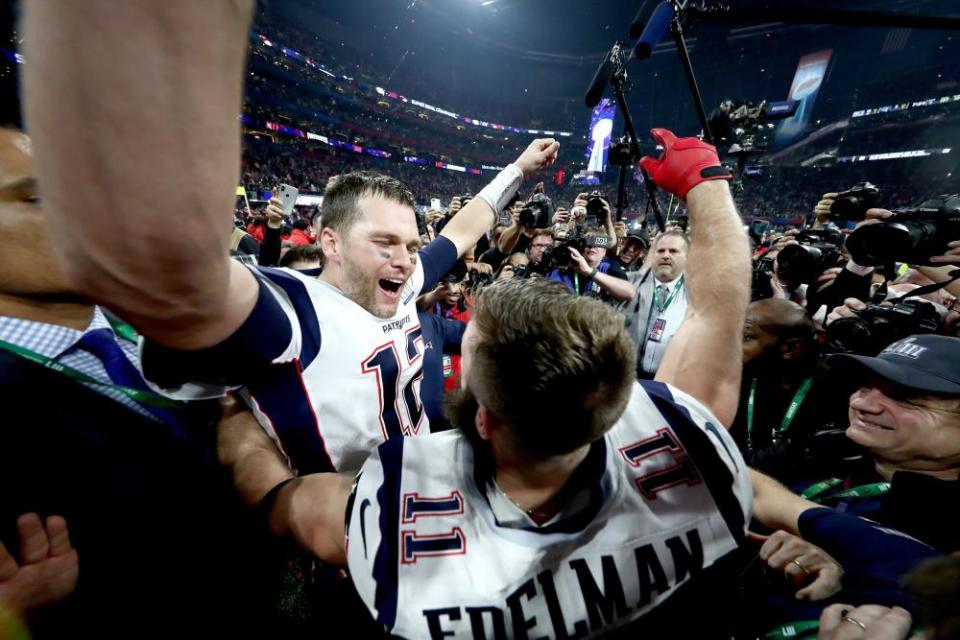The 'Formula One' secret behind Tom Brady's time-cheating dominance

On 3 August, Tom Brady turned 42. Were there a Newton’s Law of Aging, Brady would be defying it. After all, normal human beings slow down as they age. Tom Brady, not so much.
At this point, after yet another Super Bowl win, Brady has little to prove. Surely, the wounds of his sixth-round draft selection have been patched with two record-breaking decades of winning. But at an age most players are working on their golf game or talking about other players playing football on TV, Brady continues to throw touchdowns and win NFL championships.
Related: Tom Brady agrees to $70m, two-year extension with Patriots at age of 42
Maybe it’s because Brady has never really relied purely on his physical gifts.
According to Hirofumi Tanaka, an researcher of aging at the University of Texas, there can be substantial variations in how fast or slow physiological functions go down with increasing age. The good news for Brady and every other aging athlete is that a lot can be done to slow down that process.
Professional athletes in a variety of sports are playing longer, preserving performance by what Tanaka calls the “Formula One approach”, an intense focus on key athletic elements – nutrition, injury prevention, sleep, training – by the specialists or support staff that surround professional teams.
Father Time has ignored Tom Brady, at least for now. But the question is, when will Brady’s age-less weapons – his competitiveness, experience and knowledge of football – fail to compensate for an age-related decline in his arm and feet.
Let’s take a look at what happens to the physical skills with aging.
Strength
A gradual loss of muscle strength, beginning around 35, drives most of the age-related physical decline in performance. A decrease in testosterone is largely responsible for the change, leading to a decline in the size and number of muscle fibers. Ominously for Brady, some research suggests this loss of muscle mass and strength accelerates at or around 40 years old.
Unfortunately for athletes whose sports require power or explosiveness – jumping, sprinting or accelerating – the loss of fast-twitch muscle fibers is greatest, stacking the deck against basketball or football players trying to play past 40. Though the changes are inevitable, athletes, or anyone for that matter, can retard the loss of muscle mass and strength with resistance training.
Strength, not traditionally associated with the quarterback position, is critical for Brady to maintain a strong base for throwing and to help prevent injury. Brady, with the help of training guru Alex Guerrero, has been dedicated to a resistance training program for many years.

Sprinting power
After reaching peak potential at about 25 years, sprinting speed decreases by roughly 5% per decade, primarily due to a slow loss of strength. Simply put, they can’t get out of fourth gear. Older runners just can’t generate the same lower body muscle force and power-generating capacity.
The culprit? A loss in fast-twitch muscle fibers as well as a reduction in the rubber band like quality of muscles and tendons.
But of all the physical measures, this might be the least important to Brady. “Some functions like sprinting speed go down rapidly with aging,” emphasized Tanaka, director of the Cardiovascular Aging Research Laboratory at the University of Texas, “But nobody is expecting Brady to sprint anyway.”
Arm strength
“Brady has the arm strength to make every pass that he needs to,” said Dan Orlovsky, an ESPN football analyst and former NFL quarterback, “But it’s more than that, he understands the right throw for every situation.” A 13-year NFL veteran with four different teams, Orlovsky maintains that Brady’s throwing motion has been honed to become more natural and refined, with little wasted motion. That, combined with the mental understanding of when and where to throw the ball, is a big part of his continued high-level performance.
But what really impresses Orlovsky is Brady’s discipline. “We talk about his lifestyle and what he does today, but Brady’s been living this way for 15 years and is now reaping the benefit,” he said, “He’s been living with such a different mindset, one that most Americans just don’t have. He truly has slowed time.”
Vision
“What is true of Tom Brady, probably isn’t true of everyone else,” emphasized Greg Appelbaum, director of the Human Performance Optimization Lab at Duke University, “Brady has unbelievable mental skills that seemingly get better with age.” Appelbaum believes that Brady’s mental ability is in part due to a set of sensory and vision skills that has enabled him to succeed, at any age.
Related: Three years in the NFL wilderness: what Colin Kaepernick lost – and won
The key to Brady’s chessmaster-like ability to always be one step ahead? A sensorimotor skill Appelbaum refers to as prospective interference. Here’s the animal kingdom example: an animal doesn’t care where its prey is right now, they care where it will be in a few moments when trying to catch it.
The same is true in football.
To be successful, Brady needs to anticipate the position of defenders and deliver the ball to the right place and time so that it arrives when his receivers are in a position to make a play. “Brady is a master of this, and it all starts before the ball is snapped,” said Appelbaum.
But everything changes with age and sensorimotor skills are no different. The first noticeable changes typically show up in the mid-30s.
However, though some disagree about the ability to slow vision changes, more and more researchers believe that the brain can be trained like anything else. The mental exercise includes ‘brain training games’ that drill attention, working memory, and other perceptual skills. Since Brady has his own brain training modules on BrainHQ, it’s likely that he fully realizes and trains this important attribute.
Throwing mechanics
Really, almost every physical trait declines with age, and the nervous system is no different. And with the precision needed to deliver the ball to a sprinting receiver 25 yards away, small changes in coordination can lead to altered mechanics. When perhaps a younger quarterback can use athleticism to compensate for dodgy mechanics, older quarterbacks don’t have that luxury.
Related: The NFL's plan for an 18-game season: when ego and greed collide
Fixing faulty mechanics is where Tom House earns his keep. Using video analysis and a vast amount of experience, House, an expert in mechanics, has helped many a well-known quarterback fine-tune their throwing motion.
House compares the 40-year-old quarterbacks to another part of his clientele, the early teens. “You have to treat a 40-year-old quarterback like a 12-year-old,” House said. It’s all because the changes in older throwers – decreased nervous system function, flexibility and power/acceleration – typically mirror the deficits seen in a younger group of athletes.
To rebuild or refine the throwing mechanics of any thrower, House looks for the ability of the nervous system to adapt, a trait that’s often honed by playing other sports. In other words, House needs quick learners. “The more sports you experience, the more coordination you can pull off the shelf later in life,” House said.
Science, and conventional wisdom, says that we should expect Brady’s inevitable decline. Looks like it might be a while. A cocktail of hard work, genetics and good luck is keeping Brady at the top of his game.
So far, it’s Tom Brady 6, Father Time 0.

